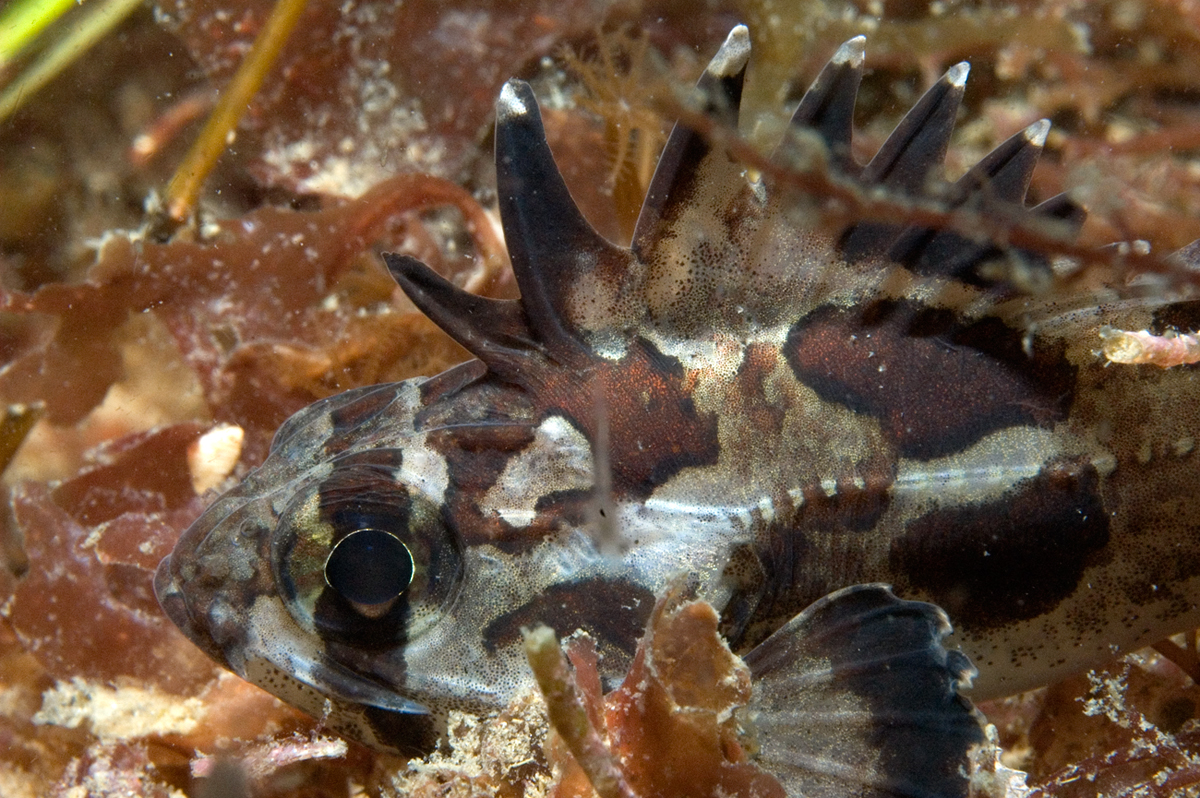Soldier, Gymnapistes marmoratus (Cuvier 1829)

A Soldier, Gymnapistes marmoratus, in Port Phillip, Victoria. Source: Julian K. Finn / Museum Victoria. License: CC BY Attribution-Noncommercial
A scorpionfish relative with venomous spines on the head and dorsal fin. The body and fins are overall pale to light brown with a mottled or marbled pattern of irregular darker blotches and spots; underside pale.
The Soldier is responsible for many stings received by net fishermen and others wading in shallow estuarine waters, especially through seagrass beds.
Soldier, Gymnapistes marmoratus (Cuvier 1829)
More Info
|
Distribution |
Endemic to temperate Australian waters, from central New South Wales, around the southern half of Australia to north of Perth, Western Australia. Inhabits seagrass areas in quiet bays and estuaries at depths to 35m. |
|
Features |
Dorsal fin XII-XIII, 7-10; Anal fin III, 4-6; Caudal fin 12; Pectoral fin 10-12; Pelvic fin I, 5; Lateral line pores 23-31. |
|
Size |
Reaches a length of about 23cm and a weight of at least 1.1kg. |
|
Colour |
Well camouflaged mottled coloration with broad irregular dark brown or nearly black blotches or marbled patches over a paler background, blotches larger and more solid above, grading topaler and more diffuse or spotted below. The blotches are less distinct in larger fish. The dorsal fin has a distinct dark blotch over the 4th–7th fin spines; pectoral fin with dark oblong spot near base; fins often with vermiculate markings or diffuse spots. |
|
Feeding |
Ambush predators that usually lie motionless during the day and are most active at night. Smaller individuals feed mostly on shrimps and crabs, whereas large fish prey upon other fishes and crustaceans. |
|
Biology |
Reaches sexual maturity between 2 and 4 years of age; synchronous spawning occurs during Spring months. Lives to at least 14 years. |
|
Fisheries |
Although of no interest to fisheries or aquaculture, the Soldier is taken as bycatch in commercial net fisheries, and on hook and line by recreational anglers. Care must be taken when handling these fish due to the venomous spines |
|
Remarks |
The Soldier is well-armed to defend itself, having venom glands associated with all head spines and all fin spines. While fatalities are rare, symptoms of envenomation may include severe localised pain, swelling, nausea, sweating, limb paralysis and collapse, and the venom may affect the cardiovascular system. |
|
Similar Species |
Although somewhat similar to the Eastern Fortescue (Centropogon australis), the Soldier grows to a larger size, lacks scales (except for lateral-line scales) and has a distinct lateral line. |
|
Etymology |
The specific name is from the Latin marmoratus (= marbled), in reference to the irregular marbled pattern on the body of this species. |
|
Species Citation |
Apistus marmoratus Cuvier, in Cuvier & Valenciennes 1829 Hist. Nat. Poiss. 4: 416. Type locality: Timor Is., south Malay Archipelago (probably in error for Western Australia). |
|
Author |
Bray, D.J. 2023 |
|
Resources |
Soldier, Gymnapistes marmoratus (Cuvier 1829)
References
Church, J.E. & Hodgson, W.C. 2001. Stonefish (Synanceia spp.) antivenom neutralises the in vitro and in vivo cardiovascular activity of soldierfish (Gymnapistes marmoratus) venom. Toxicon 39: 319–324.
Cuvier, G.L. in Cuvier, G.L. & Valenciennes, A. 1829. Histoire Naturelle des Poissons. Paris : Levrault Vol. 4 518 pp. pls 72-99. See ref at BHL
Edgar, G.J. 1997. Australian Marine Life: the plants and animals of temperate waters. Reed Books. Pp. 544.
Edgar, G.J. & Shaw, C. 1995. The production and tropic ecology of shallow-water fish assemblages in Southern Australia. II. Diets of fishes and tropic relationships between fishes and benthos at Western Port, Victoria. Journal of Experimental Marine Biology and Ecology 194: 83-106.
Grant, C. 1972. The biology of the Soldier Fish, Gymnapistes marmoratus (Pisces: Scorpaenidae). Australian Journal of Marine and Freshwater Research 23(2): 151-163.Hutchins, B. & Swainston, R. 1986. Sea Fishes of Southern Australia. Complete Field Guide for Anglers and Divers. Swainston Publishing. 180 pp.
Hopkins, B.J. & Hodgson, W.C. 1998. Enzyme and biochemical studies of stonefish (Synanceja trachynis) and soldierfish (Gymnapistes marmoratus) venoms. Toxicon 36(5): 791-793.
Hopkins, B.J. & Hodgson, W.C. 1998. Cardiovascular studies on venom from the soldierfish (Gymnapistes marmoratus). Toxicon 36(7): 973-983.
Hindell, J.S., G.P. Jenkins & M.J. Keough. 2000. Variability in abundances of fishes associated with seagrass habitats in relation to diets of predatory fishes. Marine Biology 136(4): 725-737.
Johnson, J.J. & Motomura, H. 2008. Family Tetrarogidae. pp. 498-501 in Gomon, M.F., Bray, D.J. & Kuiter, R.H. (eds). Fishes of Australia's Southern Coast. Sydney : Reed New Holland 928 pp.
Kuiter, R.H. 1993. Coastal fishes of south-eastern Australia. University of Hawaii Press, Honolulu: i-xxxi + 1-437.
Kuiter, R.H. 1996. Guide to sea fishes of Australia. A comprehensive reference for divers and fishermen. New Holland Publishers, Frenchs Forest, NSW, Australia : I-xvii + 1-434.
Kuiter, R.H. 2000. Coastal Fishes of South-eastern Australia. Gary Allen. Pp. 437.
Neira, F.J., Miskiewicz, A.G. & Trnski, T. 1998. Larvae of temperate Australian fishes: laboratory guide for larval fish identification. University of Western Australia Press. 474 pp.
Smith, W.L. & Wheeler, W.C. 2006. Venom evolution widespread in fishes: a phylogenetic rode map for the bioprospecting of piscine venoms. Journal of Heredity 97(3): 206-217.
Sutherland, S. & Sutherland, J. 1999. Venomous Creatures of Australia. Oxford University Press, South Melbourne, Victoria.
Robertson, C.H. & White, R.W.G. 1986. Feeding patterns of Nesogobius sp., Gymnapistes marmoratus, Neoodax balteatus and Acanthaluteres spilomelanurus from a Tasmanian seagrass meadow. Australian Journal of Marine and Freshwater Research 37(4): 481-489.






